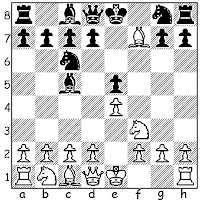In recent posts I have suggested that those who play, and those who face, the Jerome Gambit, would benefit from becoming familiar with "the classics" of that line.
That got me thinking: What would those classics be?
I have come up with a preliminary sketch. I think all of the games (except one) have appeared on this blog.
0. Jerome - Dougherty
Alonzo Wheeler Jerome has written that his first Jerome Gambit was played against George Dougherty. Although I have not yet been able to find the game, it most likely occurred before the April, 1874 issue of the Dubuque Chess Journal, where the first analysis of the Jerome Gambit was presented. Of Dougherty I know little, but the following notice occurred in the Dubuque Chess Journal, May 1875
Our Portfolio
Chess Challenge
George J. Dougherty, of Mineola, Queen's County, New York, hereby respectfully invites John G. Belden, Esq., of Hartford, Conn., to play him two games of chess by Postal Card, at his convenience, Mr. Belden taking the attack in one game and Mr. Dougherty in the other; the object being to test the soundness of Jerome's Double Opening, published in the April No. (50) of this Chess Journal.
1. Jerome - Shinkman, Iowa, 1874
The first published Jerome Gambit played by Jerome that I have been able to uncover (in the July issue of the Dubuque Chess Journal) was a loss by White.
2. Jerome - Whistler, correspondence, 1876
Largely lost to the chess-playing public, the correspondence match between Jerome and Lt. G.N. Whistler (one game survives) tested the latter's defense to the Jerome Gambit. Alas, a crushing defeat for White - who rarely, if ever, seemed to remember to mention the line thereafter.
3. Vazquez - Giraudy, exhibition, Mexico, 1876
In perhaps the most outrageous Jerome Gambit played, the Mexican champion, giving Rook odds, checkmated his opponent in 18 moves.
4. Vazquez - Carrington, 2nd Match, Mexico, 1876
This is actually a "composite" listing, as the Mexican champion played the Jerome Gambit three times (games 1, 5 and 9) in his match with William Carrington, winning them all.
5. D'Aumiller - A. P., Livorno, 1878
This miniature played in Livorno, Italy - lasting 19 moves, at which point White announced a mate in 4 - was published in the May 1878 issue of Nuova Rivista degli Scacchi, showing that the Jerome Gambit had already hurdled the ocean.
[to be continued]








